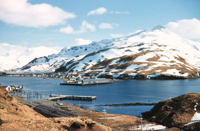Dutch Harbor-Unalaska, Alaska, and New Bedford, Mass. Remain Top Fishing Ports
July 17, 2008

Dutch Harbor in Unalaska Island, Alaska.
High resolution (credit: NOAA )
Commercial fishermen unloaded 777.2 million pounds of fish, primarily Alaskan pollock, at the port of Dutch Harbor-Unalaska, Alaska, making it the country’s top port for landings in 2007, NOAA’s Fisheries Service announced today. The port of New Bedford, Mass., claimed the top spot for value of landings, primarily due to sea scallops, bringing in $268 million in 2007. The total domestic commercial landings for 2007 were 9.2 billion pounds, valued at $4.1 billion.
Dutch Harbor-Unalaska netted the top landings slot for the 19th consecutive year, according to NOAA's Fisheries Service. Reedville, Va., ranked as the number two port for quantity of landings in 2007 with 421.0 million pounds. Empire-Venice, La., was third at 323.1 million. The major fish product landed in both Reedville and Empire-Venice was menhaden.
New Bedford was ranked number one for value of landings for the eighth year in a row, even though the port’s total landing value was down $13.4 million from 2006. Dutch Harbor-Unalaska was ranked second in value of landings at $174.1 million, which was up $8.9 million from 2006.
The new data on the nation’s ports is part of Fisheries of the United States 2007, a detailed statistical report on the nation’s commercial and recreational fishing, landings, import, export, per capita fish consumption and consumer expenditures for fish products. The report can be read online Friday.
The National Oceanic and Atmospheric Administration, an agency of the U.S. Commerce Department, is dedicated to enhancing economic security and national safety through the prediction and research of weather and climate-related events and information service delivery for transportation, and by providing environmental stewardship of our nation's coastal and marine resources. Through the emerging Global Earth Observation System of Systems (GEOSS), NOAA is working with its federal partners, more than 70 countries and the European Commission to develop a global monitoring network that is as integrated as the planet it observes, predicts and protects.
